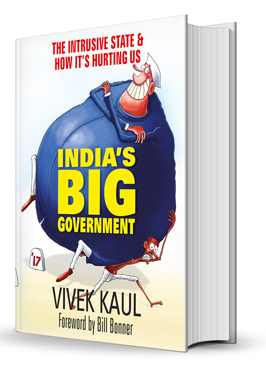
Self-employment is the new buzzword in the Narendra Modi government. And it is going to rescue the one million youth that are entering the workforce every month. Or at least that is what we are being told.
As finance minister Arun Jaitley recently told ET Now: “Bulk of the jobs in India are created by SMEs, by the micro industries, by self employment. Gone are the days where only the government sector created jobs in the government or the organised sector created jobs.”
This statement sort of makes me feel that Mr Jaitley has been reading my book India’s Big Government. (The good news is that the book is available at a huge discount on Amazon till Friday, 27th October. The Kindle version is going at Rs 199, against a maximum retail price of Rs 749, and the paperback is going at Rs 499, against a maximum retail price of Rs 999.). What Jaitley said in his statement are some of the points that I make in the book as well:
- The government (includes all forms from central government to state government to central public sector enterprises etc.) do not create jobs anymore.
- Globally, the small and medium enterprises as they grow bigger, end up creating a bulk of the jobs.
- In India, the unorganised/informal sector creates a bulk of the jobs. This is something that the Economic Survey of 2015-2016 points out: “The informal sector should… be credited with creating jobs and keeping unemployment low.”
The thing is that there is nothing new in this. Self-employment may have become the new buzzword with ministers of the Narendra Modi government, but it has been around for a while.
As the report titled Ease of Doing Business: An Enterprise Survey of Indian States: “A major challenge in India has been the preponderance of employment in very small enterprises. Formal sector jobs that exhibit high productivity and pay high wages are limited. According to the latest Economic Census, conducted during 2013 and the first quarter of 2014, of 131 million workers in industry and services, 44.4% were employed in Own Account Enterprises (OAE), which are managed exclusively by their owners and do not employ a single regular worker. Establishments with five or fewer workers, including the OAE, employed 69.5% workers and those with nine or fewer workers employed 79% workers. In other words, establishments with 10 or more workers employed just 21% of the workers in industry and services.”
The above paragraph says multiple things. Let’s look at them one by one.
- According to the latest Economic Census, conducted during 2013 and the first quarter of 2014, of 131 million workers in industry and services, 44.4% were employed in Own Account Enterprises (OAE), which are managed exclusively by their owners and do not employ a single regular worker.
Own account enterprises form a bulk of total Indian firms in services and industry. What does this mean? It basically means that anyone who does not find a job, drifts towards self-employment. Further, he starts small and continues to remain small.
Jaitley in his interview said that in order to promote self-employment “you have to have a skilling campaign which is going on.” Skilling is very important, given that the Indian education system doesn’t exactly make people employable. This is a point that I make in great detail in India’s Big Government.
The trouble is that skilling is not happening at the scale that it needs to. Let’s take a look at how things panned out in 2016-2017. The different ministries in the government had accepted a target of training 99,35,470 individuals. Of this, only 19,58,723 or around less than one-fifth had been trained up to December 2016.
As I keep pointing out, nearly 1.2 crore individuals are entering the workforce every year. This means a bulk of them continue to remain unskilled. At this rate a huge number of people who are and will enter the workforce over the next few years, will continue to remain unskilled. And given that their chances of creating social mischief remain high.
One challenge the government (and even the private sector) is facing as it tries to scale up skilling quickly is the shortage of individuals who can impart skill training. To get around this, to some extent, the talent and experience of the retired personnel of the army as well as the railways could be used. Between them, the army and the railways have many personnel who introduce, maintain and upgrade electrical and mechanical equipment of various kinds for their own use.i
- Establishments with five or fewer workers, including the OAE, employed 69.5% workers and those with nine or fewer workers employed 79% workers. In other words, establishments with 10 or more workers employed just 21% of the workers in industry and services.
This basically means that most Indian firms start small and continue to remain small. (Again, this is a point that I have made multiple times). So, just saying that small and medium enterprises create jobs, is not enough. They create many sasjobs only if they grow bigger, which in India is clearly not the case with close to 80 per cent of the firms employing less than ten workers.
So, self-employment and small and medium enterprises creating jobs, are solutions if they are allowed to grow bigger. Currently, that is not the case due to various reasons like rigid labour laws, the lack of ease of doing business and so on.
In the recent past, the informal sector has been declared to be a bad thing because it does not pay its share of taxes. The question is, does it really need to pay taxes? The own-account enterprises form a large part of this sector. And people running these firms, clearly do not make enough money to be paying taxes. Take a look at Table 1.
Table 1: Self Employed/Regular wage salaried/Contract/Casual Workers according to
Average Monthly Earnings (in %) All India
Table 1 clearly shows that 96 per cent of the self-employed make up to Rs 2,40,000 a year. Income up to Rs 2,50,000 per year does not come under tax bracket. This basically means that a large section of the informal sector in India simply does not pay tax because it does not earn enough to pay tax.
As economist Jim Walker of Asianomics wrote in a research note sometime back: “There is nothing intrinsic that says that the informal economy is a less effective or beneficial source of activity than the formal economy.” This is something that the Modi government needs to understand.
In its quest for more taxes, it is working towards destroying large parts of the informal economy, which is a huge part of Indian economy.
Yes, self-employment is important. But then the government is saying one thing and doing exactly the opposite thing. What explains this dichotomy?
The column originally appeared in Equitymaster on October 23, 2017.




